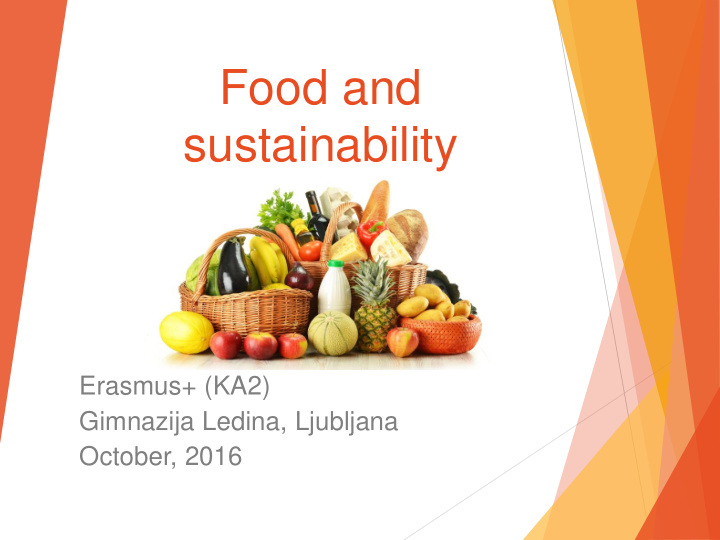



Food and sustainability Erasmus+ (KA2) Gimnazija Ledina, Ljubljana October, 2016
K.W.L. chart What I already know? What I want to know? What I have learned?
FOOD VOCABULARY Nutrients Traditional country Proteins, fats, dishes carbon hydrates Raw/cooked food Vitamins, minerals, Balanced healthy water, fiber and diet and health phytochemicals Fast food and Vegetables, fruits, obesity grains, legumes, meat, fish Digestion and metabolism
FOOD consists of: MACRONUTRIENTS (calories) - FATS (animal and plant) - PROTEINS (animal and plant) - CARBOHYDRATES (simple and complex)
FOOD consists of MICRONUTRIENTS (no calories) We find good things (in fruits): - VITAMINS, - MINERALS, - PHYTOCHEMICALS, - WATER, - FIBER.
SWEETENERS NATURAL ARTIFICAL Raw Honey Saccharin Natural Stevia Sucralose Dates Aspartame (Nutrasweet) Coconut Sugar Isomalt Maple Syrup
SUSTAINABLE FOOD Better technical knowledge on the environmental impacts of food Stimulating sustainable and locally food production Promoting sustainable and locally food consumption Reducing food waste and losses (Do not throw food away! Just eat it!) Improving food policy
WHY TALK ABOUT SUSTAINABLE FOOD? Food is essential to life. It also forms an important part of our cultural identity, and plays an important role in the economy. People are aware that the food they eat is an important factor affecting their health, but what is less well known is the impact producing and consuming food has on the world's resources.
AGRICULTURE FRUITS PRODUCTION VEGETABLES PRODUCTION VITICULTURE
FRUITS are healthy, come from plants, most of them are convenient, have fiber, water, vitamins, minerals and phytochemicals (antioxidants), have significant chewing resistance.
FRUITS are fulfilling (most people are satisfied after one large apple, which contains 23 grams of sugar, 13 of which are fructose), when fructose hits your liver slowly and in small amounts, then your body can easily take care of fructose, fiber can reduces cholesterol levels, slow absorption of carbohydrates and increase satiety, tend to be high in several vitamins and minerals; especially vitamin C, potassium and folate, eat variety of fruits – different fruits contain different nutrients.
FRUITS Many human studies show that fruit intake is assocciated with lower risk of cholesterol, heart attacks, stroke, diabetes type II and some types of cancers, eating more of apples and oranges lead to automatic reduction in calorie intake, the main reason to avoid fruit include some sort of intolerance (fructose intolerance) or being on very law – carb / ketogenic diet.
FRUITS Fruit juices and dried fruits are always a bad idea. Fruit juices contain a lot of sugar, no fiber and no chewing resistance. Dried fruits (like raisins) can be a problem as well. They are very high in sugar and it is easy to consume large amounts. Smoothies are somewhere in the middle. They are better than drinking fruit juice, but not as good as eating whole fruit.
FRUITS - CALORIES
FRUIT PRODUCTION IN SLOVENIA organic (eco = bio), 20 % integrated, 80 %.
STATUS OF FRUIT PRODUCTION 10 fruit growing areas in Slovenia, 2 – 3 % of all agricultural land, 5.000 ha intensive orchards. 25 fruit species can be grown in Slovenia.
The mainly species of fruits in Slovenia APPLES, PEARS, PLUMS, PEACHES, GRAPES, APRICOTS, STRAWBERRIES.
STATUS OF FRUIT PRODUCTION The most important specie of fruits are apples with 70 % of total fruit production.
The varieties of apples -> NEW varieties of apples: jonagold, idared, golden delices -> OLD varieties of apples
Under the Skin of Fruits Under the skin of every apple, orange, banana, or fruit, there is more than just sweetness .
Colors -- lots of them “ While modern Medicine science has discovered many impressive advances, nothing even comes close to the health-promoting, disease fighting benefits of colorful fruits and vegetables...”
The Colors of Health Phytochemicals (plant chemicals) not only protect plants, they protect us too! From cancer to anti-aging, heart disease to eyesight, scientists focus on a range of health benefits .
Variety Each color offers a different health benefit. Eat all the colors to get all the benefits. No individual color does it all!
Blue/Purple The blue/purple group offers phytochemicals such as anthocyanins and phenolics. These benefit you by providing antioxidant and anti-aging effects.
Blue/Purple It helps to maintain memory function , prevent u rinary tract infection , and it lowers the risk of some cancers.
What can I eat in the Blue/Purple Group Blackberries Blueberries Plums Currants Purple Grapes Raisins
Green Green fruits contain lutein and indoles, have the potential to lower the risk of some cancers, promote vision health, and are partially responsible for strong bones and teeth.
What can I eat that is Green? Avocados Honeydew Melon Limes Grapes Kiwi
White and Brown Alliicin, the photochemical in this group is responsible for heart health, lowering Cholesterol levels, and lowering some risks of cancer.
What can I eat that is in the white/brown group? Bananas Dates Brown Pears Ginger
Yellow/Orange Yellow & orange fruits & vegetables contain vitamin C, carotenoids, & bioflavonoids, which help maintain a healthy heart, vision health, a healthy Immune System, & lowers risk of some cancers.
What can I eat that is Yellow or Orange? Tangerines Oranges Lemons Pineapple Mango Cantaloupe Papaya
RED The Red group offers photochemicals such as quercetin, lycopenes & anthocyanins . These provide antioxidants & anti-aging effects. Helps maintain memory function , healthy heart, urinary tract health , & lowers the risk of some cancers.
What can I eat in the Red Group Red apples cherries, berries cranberries raspberries currants pomegranates watermelon nectarines peaches strawberies
How much should we eat? Minimum – 5 servings a day Recommended – up to 11 servings a day
Phytochemicals Just as colors give the rainbow its life; so do phytochemicals give us a chance for a healthy life.
Eat the Color Way! Reduce your risk of disease & be healthy!!!
HEALTH BENEFITS OF EATING FRUITS Lower your risk at stroke, heart disease and high blood presure! Reduce your risk of type diabetes 2! Lower your risk of certain types of cancer! Help manage weight! Look and feel great!
Recommend
More recommend